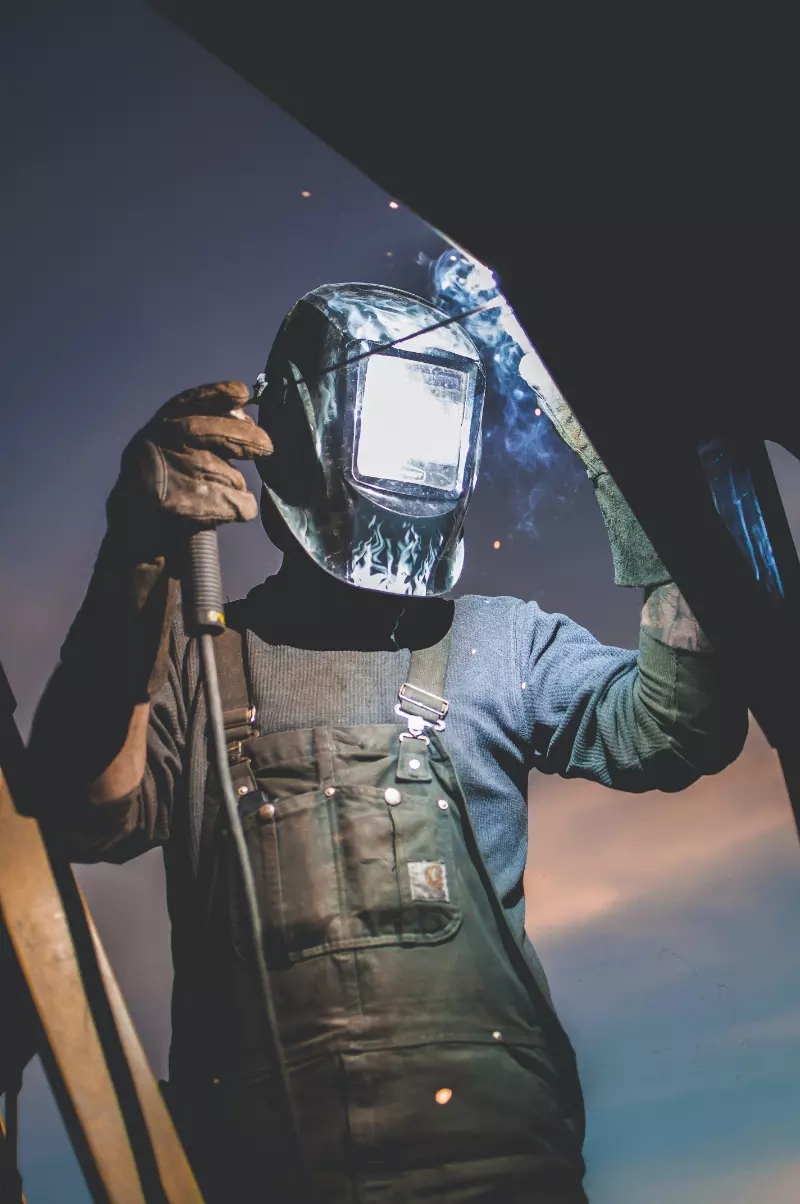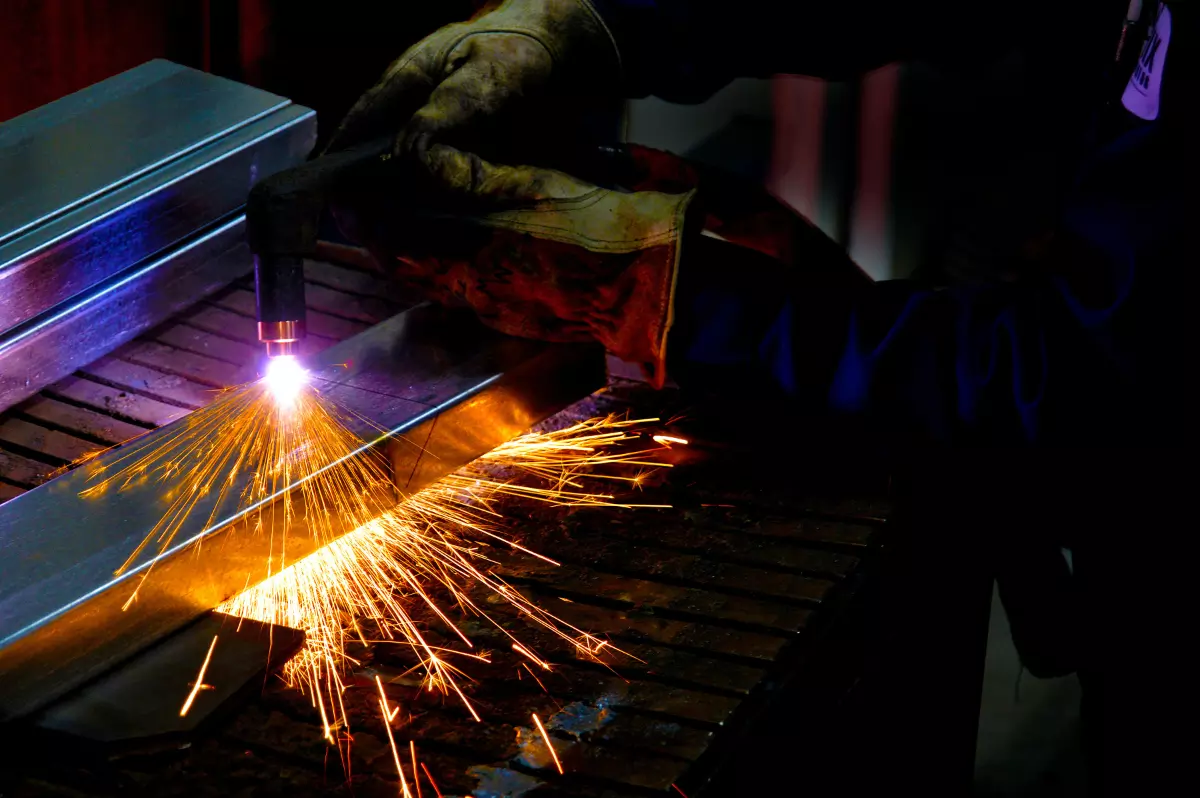Find out more about: how does MIG welding work? We ask: what are the advantages of MIG welding? And what are the disadvantages of MIG welding?
What Is MIG Welding, & How Does It Work?
MIG, or Metal Inert Gas welding, is a commonly used welding process that relies on a solid wire electrode thread through the welding gun/torch to join the two workpiece materials. The torch also provides a shielding gas for the liquified metal pool to prevent atmospheric contamination.
The MIG is easy to learn and use, allowing home DIYers, artists, and more to weld themselves. MIG welding is also a versatile technique; used for thick and thin materials; this flexibility turns many to use MIG welding. MIG welding is categorised under Gas Metal Arc Welding (GMAW), along with close relative MAG (Metal Active Gas).
Safety First!
Don't forget to use a proper set of welding protection equipment when beginning any welding task. No matter how much experience you have, a small mistake or distraction can be catastrophic for yourself and those around you.
Having safe welding equipment, with no obvious problems, along with protection equipment ensures safety. Ensure you have access to the required standard protection for MIG welding. A list follows;
- Welding Gloves
- Glasses
- Dimming Helmet
- Work Shoes
- High-quality fire-proof jacket
MIG Welding Process
MIG welding is a versatile technique that can be transferred to thick and thin materials. The MIG welding process works by creating an arc between the tip of the wire electrode and the workpiece material in turn, melting both to develop a weld pool.
The wire provides a heat source to melt materials, as well as transferring filler metal to weld the joint. A copper contact tube is used to encase the wire, as this conducts the welding current needed for the wire.
After the materials have melted into a weld pool, an inert shielding gas comes from the end of the torch to protect from atmospheric contamination.
The type of shielding gas chosen will depend on the material being welded and the proposed application. The three pure welding gases are helium, carbon dioxide and the most popular Argon.
During the welding process, the wire is motor driven and fed from a reel. The wire can be either solid (simply drawn wire) or cored (formed using a metal sheath and powdered flux OR metal filling).

MIG welding can offer high productivity rates as the wire is continuously transferred by motor power. During the welding process, the wire is positively charged and connected to the power source; this, in turn, delivers a consistent voltage. The welding current achieved is determined by the wire diameter (between 0.6 and 1.6mm) and wire feed speed.
The burn-off rate of the wire and feed speed will form an equilibrium to deliver the weld current. Often referred to as a semi-automatic process, MIG welding uses the power source for the wire feed rate and arc length. Yet, the wire position and travel speed are manually controlled.
Further mechanisation of the process can be achieved when the welder doesn't directly control the process parameter. Without manual intervention, the process can be considered automatic.
Does MIG Welding Require Gas?
Firstly, to clear things up, there is absolutely no such thing as truly 'Gaseless' MIG welding. During welding, the weld pool must be protected from Oxygen in some way, and this is done by replacing the air with gas. So what does 'Gasless' MIG welding entail?
Well, it's actually a 'self-shielding technique. A self-shielding MIG Wire has a flux core instead of using gas. Flux is the chemical flowing agent used to weld together materials during gasless welding. At the same time, the welding arc melts the wire and burns the flux, in turn producing a gas shield around the weld pool.
Therefore, even 'Gasless' MIG welding isn't entirely gasless. Simply, the self-shielding wires don't require a cylinder of gas, hence the somewhat misfitted name.
Many welders prefer the standard MIG or TIG gas welding technique. Although gasless welding has its uses, it creates a fierce arc that's difficult to use when working with thinner steel (around 1.2mm). Moreover, 'gasless' welding produces a lot of nasty smoke, so it's not ideal in smaller inside spaces. The self-shielding, 'gasless' technique can be used outside when it's too windy for other techniques.
What Are The Advantages Of MIG Welding?
There are various advantages to using MIG welding; below, we break down these reasons and explain the environment, materials and expectations it's most suited for.
- One of the key advantages of using MIG welding is the higher rate of weld metal deposition compared to other techniques. As the electrode is automatically fed for Gas metal arc welding (GMAW) processes, whilst techniques like Shielded Metal-Arc Welding (SMAW) or Gas tungsten arc welding (GTAW) require manual feeding of the electrode.
- Using flux shielding for the arc can cause slag entrapment in the weld metal, causing problems during welding. The GNAW processes, like MIG, don't utilise flux to shield the arc; instead, inert gas is used. Therefore, there is no risk of slag entrapment.
- Using flux can cause a loss of alloying elements owing to a chemical reaction. Yet, with MIG welding, there is no flux used; instead, a shielding gas is used to protect the weld pool from external interference. Meaning, with MIG, there is no chance of loss of alloying elements.
- Gas metal arc welding (GMAW) is a versatile process, useable on a variety of metals from copper to steel, as well as alloys of many metals. MIG also uses higher quality wires, which produce higher quality welds.
- MIG welding is generally semi-automatic, although it can easily be an automatic method. This automation makes MIG an easy choice and allows beginners to learn quickly.
- With MIG, there is much less post-welding cleaning required, as no slag has chipped off the weld.
What Are The Disadvantages Of MIG Welding?
MIG welding has little to no disadvantages; however, the few issues you may experience are listed below;
- When completing an 'out of position' weld, MIG welding can prove difficult. If the weld is in a vertical or overhead position, it causes a greater-sized weld pool with higher fluidity. Although, this can be mitigated by using a low-diameter welding wire.
- For the GNAW process, the construction of equipment can be considered quite difficult when compared to Shielded Metal-Arc Welding (SMAW) techniques.
- Wherever you are planning to complete GNAW welding, including MIG, a gas cylinder must be carried on the person. So, for farmers or others completing fieldwork over large acres, the availability of a shielding gas cylinder can be detrimental and demand the use of another type of welding.
Short History of Self-shielding Wires
First developed in the USA for use on prairie farms in the midwest. Self Shielding MIG wires were lightweight and portable.
A small hand-held MIG welder using a deep cell 24v Tractor batter was developed to allow farmers to spot repair gates, fences and more out in the vast fields.
By the 1980s, the UK DIY welder market gained access to Self-shielding MIG wires. This was before welding equipment like disposable gas cylinders were made available.

Key Rules for MIG welding
A common phrase is 'If it produced slag, you drag' - Slag refers to the meltable solution produced during flux wielding. Thus, when welding using a stick or flux wire, you should drag the rod along the material. But, for metal inert gas welding (MIG), you should push the wire.
Various types of welding angles are taken on, including; Flat, Vertical, Horizontal, Overhead Pipe and Groove. There are two distinctions in regards to angles.
Firstly, the 'travel angle' refers to the welding gun's angle in relation to a vertical orientation each, whilst the 'work angle' refers to the angle of the gun to the metal material.
The speed you weld can impact the quality of the finish. For instance, a slower travel speed will produce a wider and more convex bead that penetrates shallowly and deposits an excess of metal.
Alternatively, too high-speed travel creates shallow welds with a narrow and highly concaved bead. Generally, with MIG, most travel speeds are well below 40 inches per minute, with the ridge being approximately 3/8 inch behind the wire electrode.
The welding arc should remain within the leading 1/3 of the weld pool; if not, the travel speed likely requires adjustment. More specifically, for MIG welding, the distance should be between 3/8 to 1/2 an inch.
Beginner Tips & Tricks for MIG Welding!
Starting to learn about MIG welding can be a lot to take on at once, and a lot of websites use terminology you may not be acquainted with. Below we offer a succinct list of the top tips for beginner MIG welders and hardcore DIY enthusiasts. As well as some basic definitions for welder terminology.
01. The Surface Needs To Be Clean
02. Use The Right Stick Out Length
03. Get A Better Ground Clamp
04. Push Or Pull, Which To Use
05. Keep The Torch At The Right Angle
06. Use An Uphill Welding Method For Thick Metal
07. Use A Darkening Helmet
08. Use A Suitable Electrode
09. Test The Metal You Are Working With
10. Try To Avoid Big Welding Guns
11. Use Short Wires For Thicker Metals
12. Have Extra Tips At Hand
13. Use The Right Shielding Gas
14. Select Electrode Polarity & Gas Flow
15. Ensure You Use The Right Welder
16. Speed Of Your Gun Movement
Definitions of welding terminology
An electric arc forms between the convertible MIG wire electrode and the workpiece metal material to heat the workpiece metal and cause a fusion of the two materials.
This includes MIG welding (Metal Inert Gas) and MAG welding (Metal Active Gas)
A non-consumable tungsten electrode point is used to produce the weld, with an inert shielding gas (either Argon or helium) being used to protect the weld pool from oxidation and other atmospheric interference.
This includes TIG welding (Tungsten Inert Gas)
A manual arc welding process that utilises a consumable electrode shielded by flux.
This includes MMA (Manual Metal Arch Welding) and Stick welding techniques.
Are you looking for welding equipment suppliers in Coventry and Warwickshire. Contact our welding equipment specialists working across Coventry, Rugby, Oxford and the surrounding areas.


